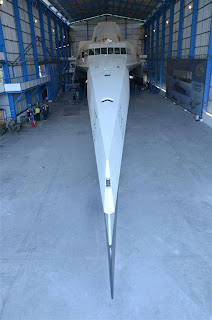GENERAL DISCRIPTION
The Fast Missile Patrol Vessel (FMPV)
employs a modern “Wave Piercing” trimaran design. This
allows the vessel to cut-through waves rather than rise up
and over them, and the increased beam provides inherent
stability. This combination of features reduces both
pitching and rolling, creating a stable weapons platform,
and enabling the vessel to comfortably and safely maintain
higher average speeds in adverse conditions.
The FMPV has “Stealth” design characteristics, and
incorporate features that minimise detection by reducing
Radar, Infra-Red, Acoustic and Magnetic signatures. Stealth
properties are further improved as there are no
reverse-angle bow overhangs to reflect radar signals, as
seen on conventional hull forms. Weaponry, including
missiles and naval guns, and the ships 11 m high-speed RHIB,
are discreetly concealed or shaped to meld into the
superstructure profile.
The wide decks on the 63m OPV Trimaran also make it an ideal
platform for carrying a helicopter, which extends the
effective patrol range and capabilities of the vessel.
CONSTRUCTION
Construction is from strong and highly
durable, lightweight composite carbon fibre sandwich,
utilising vinylester modified epoxy resin and the vacuum
resin infusion process. Thus ensuring improved fuel
efficiency, and reduced operational, maintenance, and life
cycle costs.
If equipped with waterjets the draft is just 1.2 m. Allowing
operations both offshore and close inshore, with a much
reduced risk of damage to the propulsion system from
floating debris or grounding.
With lower maintenance requirements and automated control
systems, the vessel can be operated by a crew of only 23.
This can be augmented with a Special Operations Unit of 7
personnel, with their own dedicated crew quarters.
ADVANTAGES
Over the past 20 – 30 years, catamarans
have overtaken monohulls as the preferred design in many
marine activities, and now trimaran designs are also
becoming more common. Known collectively as multihull
designs, they now serve in rolls as warships, commercial
vessels, ferries, service and support vessels, fire fighting
boats, pleasure boats, and importantly Search and Rescue
craft. Modern multihulls have fine bows that slice through
waves and reduce pitching, which allows them to maintain
higher speeds in rough conditions, and reach an accident
scene faster.
By contrast, conventional mono-hulled
vessels tend to slam into waves and roll excessively from
side to side, and must slow down considerably in heavy
weather. This rolling also makes it difficult to launch
their onboard rescue boats, and increases the risk of injury
when retrieving victims directly from the water. Even after
a successful rescue, this rolling can exacerbate injuries to
victims who have sustained spinal damage.
A noticeable features of the multihull
design, is increased beam. This additional width increases
stability, making rescues safer, and gives increase space to
take more victims on board. In a ferry disaster this enables
more people to be saved, and with a much reduced chance of
capsize. This happens on mono-hull vessels when they become
overloaded and top-heavy.
Due to their form and lighter
displacement, multihulls tend to sit on the water, rather
than in the water. This gives them a much shallower draft,
and enables them to operate in relatively shallow water.
Giving the potential to get closer to stranded vessels, and
enter shallow bays and estuaries. This is a significant
advantage in situations where harbour infrastructure does
not exist, or may have been damaged by tsunami or
earthquakes.
Additional features include:
-
Less resistance
because the longer narrow hulls give a higher length:
beam ratio.
-
Less resistance
because of lighter displacement. (Composite is 30%
lighter than aluminum)
-
Less Drag =
higher speed… or… less fuel consumption = longer range.
-
Improved
maneuverability and course stability
-
Multi-role
capability… can be used for patrol, humanitarian and
disaster relief.
3d modelling
the pattern is for Indonesian only for while, overseas coming soon
got a bad news.. this morning (September 28th, 2012) almost one month since it was launched, the ship burn out. While we wait for complete investigation...
RIP KRI KLEWANG...JALESVEVA JAYAMAHE!
price :US $2
buy now
here please give some note the model name in paypal transaction and choose "send as give/friends" option
for Indonesian you can have it
here










































































